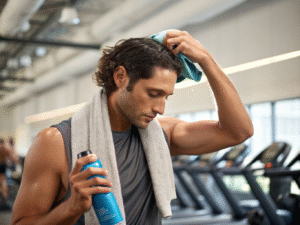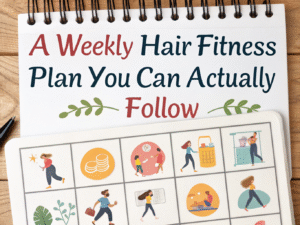If your hair had a gym membership, it would be on the treadmill three times a week, sip protein shakes, and brag about its shine. Good news: you don’t need a treadmill for your scalp. Hair “fitness” is about consistent, smart care that keeps your hair strong, resilient, and growing well. This guide blends science, simple routines, and a dash of humor to help you build a highly effective, SEO-friendly hair care routine that supports long-term hair health.

Table of Contents
ToggleWhat “Hair Fitness” Really Means
Think of hair fitness as the overall performance of your strands and scalp. The goals:
- Strong cuticles with minimal breakage and split ends
- Balanced moisture and elasticity (less snapping, more bounce)
- Healthy scalp microbiome and pH balance
- Consistent hair growth cycles with minimal shedding
- Shine that looks intentional, not accidental
Key players:
- Follicle: the tiny factory in your scalp where growth happens
- Sebaceous gland: produces sebum to lubricate hair and protect the cuticle
- Cuticle: the outer shield; smooth cuticles = shine and fewer tangles
- Cortex: where strength, color, and texture live
Must Read: The 10 Best Vegan Meal Delivery Services in 2025
The Daily Hair Fitness Routine (Simple and Sustainable)
You don’t need 17 products. You need consistency.
- Cleanse strategically
- Frequency: 2–4 times per week for most; more if very oily or you work out daily, less if very dry or textured.
- Use a gentle, sulfate-free shampoo for routine cleanses; save stronger cleansers for buildup.
- Focus shampoo on the scalp, not the ends. Your ends will get clean when you rinse.
- Condition like you mean it
- Apply conditioner from mid-length to ends; comb through with a wide-tooth comb in the shower to detangle.
- Deep condition or use a hair mask weekly to repair and hydrate. Look for ingredients like hydrolyzed keratin, amino acids, glycerin, and ceramides.
- Protect, then style
- Use a leave-in conditioner for slip and hydration and a heat protectant before any hot tool.
- Limit heat to 300–350°F (150–180°C) and keep passes quick.
- Rotate in protective styles (loose buns, twists, braids) to reduce friction and breakage.
- Scalp care is non-negotiable
- Massage your scalp for 3–5 minutes a day to support blood circulation and a happy follicle environment.
- If you use dry shampoo, clarify weekly to avoid clogged follicles.
- Trim on a schedule
- Trim every 8–12 weeks to manage split ends and preserve shape. Trims don’t make hair grow faster; they just prevent frayed ends from traveling.
Sweat, Workouts, and Hair Care: Gym-Proof Your Routine
Sweat is great for your body, less great for your scalp if it lingers.
- Pre-gym: Use a lightweight leave-in or a little scalp-friendly serum to buffer sweat salts.
- During: Wear a soft, absorbent headband. Avoid super-tight ponytails that stress your hairline (hi, traction alopecia).
- Post-workout: Rinse scalp or co-wash if needed. If you’re washing later, use a gentle scalp mist or dry shampoo on roots and let hair fully dry to prevent odor and irritation.
- Switch to snag-free scrunchies instead of elastic bands.
Nutrition for Hair Growth and Hair Health
Hair is a protein fiber. Feed it accordingly.
- Protein: Aim for roughly 0.8–1.2 g protein per kg of body weight daily, from eggs, fish, poultry, tofu, Greek yogurt, lentils.
- Iron and zinc: Critical for hair growth; find them in lean meats, legumes, pumpkin seeds, spinach.
- Omega-3s: Salmon, sardines, walnuts, chia seeds support scalp health.
- Vitamins C, D, E and biotin: C aids collagen synthesis; D supports follicle cycling; E is an antioxidant; biotin supports keratin infrastructure (most people get enough through diet).
- Silica and collagen: May support hair strength and resilience.
- Hydration: 2–3 liters of water daily keeps hair and scalp from feeling like a desert film set.
- Avoid crash diets: Sudden calorie cuts can trigger shedding (telogen effluvium). Slow and steady wins the growth race.
Note: If you notice sudden hair loss, pronounced thinning, or patchy shedding, consult a dermatologist or trichologist to rule out deficiencies or medical causes.
Scalp Health 101: Dandruff, pH, and Happy Microbiomes
A healthy scalp = better hair output.
- Keep pH balanced (around 4.5–5.5). Over-washing with harsh cleansers can disrupt sebum and barrier function.
- For flakes: Use anti-dandruff shampoos with zinc pyrithione, ketoconazole, selenium sulfide, or salicylic acid. Rotate them weekly for best results.
- Exfoliate gently: A salicylic acid scalp treatment once every 1–2 weeks can reduce buildup.
- Don’t smother the scalp with heavy oils daily; occasional light oiling is fine, but buildup suffocates follicles.
Read More: The GLP‑1 Era: A Fitness‑Forward Guide to Modern Weight‑Loss Medications
Ingredients: What to Use and What to Skip
Use
- Gentle surfactants, sulfate-free shampoos for frequent washes
- Humectants (glycerin, panthenol), emollients (shea, aloe), and proteins (hydrolyzed keratin, silk amino acids)
- Heat protectants with silicones like dimethicone or amodimethicone—they can reduce heat damage and frizz
- Botanical oils like argan, jojoba, grapeseed; rosemary and peppermint oils may support scalp comfort (patch test first)
Consider limiting
- Harsh sulfates (SLS/SLES) if you have dry hair or color-treated hair
- Drying alcohols and heavy fragrance if you’re sensitive
- Frequent bleaching or overlapping chemical treatments; these raise porosity, lift the cuticle, and increase breakage risk
Heat Styling, Color, and Chemical Treatments
- Air-dry partially: Towel blot, then air-dry 70–80% before blow-drying on medium heat with a nozzle.
- Pressing/curling: Use the lowest effective temperature, keep hair fully dry, and do a single quick pass.
- Color care: Opt for bond-building treatments, use color-safe, sulfate-free shampoo, and add weekly masks.
- Chemical relaxers and perms: Space treatments 10–12 weeks apart, and deep condition religiously.
Environment: Hard Water, Chlorine, Humidity, and UV
- Hard water: Use a chelating shampoo monthly (EDTA or citric acid) or install a shower filter to prevent mineral buildup and dullness.
- Swimming: Pre-soak hair with clean water, apply a leave-in conditioner, and wear a swim cap. Rinse immediately after and use a gentle cleanse.
- Humidity: Seal with a light serum; look for anti-humidity polymers.
- UV exposure: Use UV-protective hair mists or wear a hat. Sun degrades pigment and roughens the cuticle.
Sleep and Friction: Nighttime Hair Care
- Pillowcases: Switch to silk or satin to reduce friction, frizz, and tangles.
- Protective styles: Loose braid or pineapple for curls.
- Never sleep with wet hair: Damp fibers are fragile; let hair dry or diffuse before bed.
Common Hair Problems and Quick Solutions
- Hair loss/thinning hair: Ensure adequate protein, iron, vitamin D; reduce traction from tight styles; manage stress and sleep. If shedding is sudden or heavy, seek professional advice.
- Dandruff vs. dry scalp: Dandruff is often yeast-related—use anti-dandruff actives. Dry scalp needs hydration and gentle cleansing.
- Split ends: Only trimming removes splits; masks and serums temporarily smooth them. Prevent with heat protection and gentle detangling.
- Breakage: Use a wide-tooth comb, detangle from ends upward, add protein treatments as needed, and avoid brushing wet hair unless it’s saturated with conditioner.
- Oily roots, dry ends: Cleanse scalp more often, condition ends only, and use lightweight leave-ins.
Hair Myths vs. Facts
- Myth: “Trimming makes hair grow faster.”
Fact: It prevents splits from traveling, preserving length—but growth happens at the scalp. - Myth: “Oil moisturizes hair.”
Fact: Oils seal; water and humectants hydrate. Use both for balance. - Myth: “Cold water closes cuticles.”
Fact: Cuticles respond more to pH and products than temperature. Cool rinses can reduce swelling but won’t “lock” the cuticle by themselves. - Myth: “Daily shampooing is bad.”
Fact: It depends on scalp type and lifestyle. Gentle formulas can be used frequently if needed.
A Weekly Hair Fitness Plan You Can Actually Follow
- Monday (Cleanse + Condition): Scalp-focused shampoo, conditioner mid-to-ends, cool-to-lukewarm rinse. Leave-in + heat protectant if styling.
- Tuesday (Scalp Massage + Protective Style): 3–5 minutes massage; loose bun, braid, or twists.
- Wednesday (Workout Day Quick Refresh): Co-wash or rinse scalp post-sweat; apply lightweight leave-in; air-dry or diffuse.
- Thursday (Deep Conditioning): Shampoo, then a protein-moisture balancing mask (10–20 minutes). Detangle gently.
- Friday (Style Smart): Blow-dry on medium with heat protectant; add a few low-temp curls if you must.
- Saturday (Clarify/ Chelate as needed): Use a clarifying shampoo if you’ve used a lot of product or swim often; follow with a rich conditioner.
- Sunday (Rest + Reset): Scalp massage, light oil on ends, satin pillowcase, gentle braid for sleep.
Adjust frequency based on your hair type: coily and highly textured hair often benefits from less frequent shampooing and richer conditioning; fine or oily hair may prefer more frequent light cleansing and minimal heavy creams.
When to See a Professional
- Sudden or patchy hair loss, scalp pain, persistent dandruff, sores, or excessive shedding that lasts more than a few weeks.
- A dermatologist or trichologist can evaluate for anemia, thyroid issues, hormonal changes, or scalp conditions and recommend targeted treatments.
The Takeaway: Consistency Beats Complexity
Healthy hair doesn’t demand a 12-step routine or mysterious potions. It asks for:
- A balanced scalp (clean but not stripped)
- Smart conditioning and regular protection
- Respect for heat and chemical processes
- Nutritious food, hydration, sleep, and stress management
- Gentle handling and consistent trims
Treat your scalp like skin, your hair like fabric, and your routine like a fitness plan: steady, supportive, and sustainable. Do that, and your hair will flex its shine without ever stepping onto a treadmill.
Conclusion: Your Roadmap to Hair Health and Fitness
Healthy hair isn’t a mystery; it’s a routine. When you build a consistent hair care plan—cleanse the scalp without stripping, condition for moisture and strength, protect from heat and friction, and nourish from the inside out—you stack the deck in favor of stronger, shinier, fuller-looking hair. Pair that with smart styling, scalp care, and realistic expectations, and your strands will retire their tiny imaginary gym membership because your routine does the heavy lifting.
Think of your approach like a fitness program:
- Keep the scalp balanced and clean so follicles can do their best work.
- Use deep conditioning and protein as needed to improve elasticity and reduce breakage.
- Respect heat tools and chemical services with heat protectants and bond-building products.
- Eat enough protein, get your iron and vitamin D checked if shedding spikes, and hydrate like you mean it.
- Reduce friction at night, trim on schedule, and avoid tight styles that stress the hairline.
If you’re not sure where to start, try this mini challenge for the next four weeks:
- Do a 3-minute scalp massage daily.
- Use a heat protectant every single time you use a hot tool.
- Deep condition once a week and clarify or chelate once a month if you have buildup or hard water.
Small, steady habits beat heroic, one-off treatments every time. Give your scalp patience, your ends kindness, and your routine consistency, and your hair health and fitness will follow.
FAQs: Hair Health and Fitness
Q1: How long does it take to see visible improvement in hair health and growth?
A: Your strands aren’t Amazon Prime—they need a little time. Most people notice smoother texture and more shine in 2–4 weeks with consistent conditioning and heat protection. Reduced breakage and fewer split ends often show up around 6–8 weeks, since trims and treatments need time to work. True growth and density changes are slower: hair grows about 1–1.3 cm per month, so give it 3–6 months to judge progress. If you see sudden, heavy shedding for more than 6–8 weeks, check in with a dermatologist to rule out deficiencies or scalp conditions.

Zain Ul Hassan is the founder of Zaha Fitness. He writes practical, research-backed articles on fitness, weight loss, and natural health. His goal is to help people live healthier lives using simple and effective tips.



